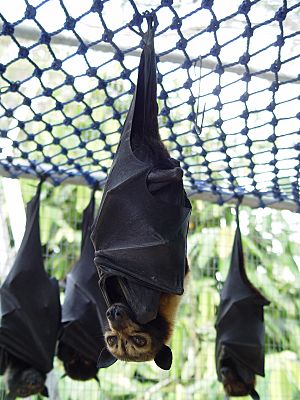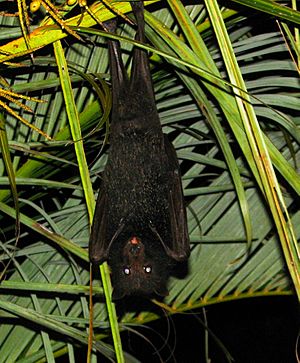List of bats of Australia facts for kids
Australia is home to around 75 different types of bats! This amazing list tells you all about the bats found here, including those on Lord Howe Island and Christmas Island. These bats are a special part of Australia's animal life, and you'll learn about some of the most interesting ones.
Meet Australia's Bats

Bats are the only mammals that can truly fly! They are super important for our environment. They help pollinate plants and control insect populations. In Australia, bats are divided into different families, each with unique features. Let's explore some of them!
Flying Foxes (Pteropodidae)
This family includes the "flying foxes" or "fruit bats." They are usually larger than other bats and have big eyes, which they use to see at night. They love to eat fruit, nectar, and pollen. You'll often see them hanging upside down in large groups called "camps."
- Spectacled flying fox (Pteropus conspicillatus): You can spot these bats by the light yellow rings around their eyes, which look like spectacles! They live along the coast of Queensland and also in New Guinea.
- Black flying fox (Pteropus alecto): These are common in northern Australia. They are big bats with dark fur. They also live in New Guinea and Indonesia.
- Grey-headed flying fox (Pteropus poliocephalus): This bat is special because it's endemic to Australia. This means it's found nowhere else in the world! You can see them along the east coast, from Rockhampton down to Adelaide.
- Little red flying fox (Pteropus scapulatus): These bats are smaller and have reddish-brown fur. They travel widely across northern and eastern Australia, sometimes in huge groups.
Ghost Bats (Megadermatidae)
There's only one type of bat from this family in Australia, and it's quite unique!
- Ghost bat (Macroderma gigas): This bat is also endemic to Australia. It's one of the largest bats in Australia and has very big ears. Ghost bats are carnivores, meaning they eat other animals. They hunt insects, frogs, lizards, birds, and even small mammals like mice! They are found across northern Australia.
Horseshoe Bats (Rhinolophidae)
These bats get their name from the horseshoe-shaped skin folds on their noses. These nose leaves help them direct the sounds they make for echolocation. Echolocation is like a built-in sonar system that helps them find their way and catch prey in the dark.
- Eastern horseshoe bat (Rhinolophus megaphyllus): Found along the east coast of Australia and in New Guinea.
- Large-eared horseshoe bat (Rhinolophus robertsi): This bat lives in northeast Queensland and has, as its name suggests, very large ears!
Leaf-nosed Bats (Hipposideridae)
Like horseshoe bats, leaf-nosed bats also have special nose structures. Their nose leaves can be very complex and help them with echolocation.
- Dusky leaf-nosed bat (Hipposideros ater): Found in Northern Australia, but also in parts of South East Asia.
- Orange leaf-nosed bat (Rhinonicteris aurantia): This bat is famous for its bright orange fur! It's endemic to Australia and lives in places from the Pilbara region to north-western Queensland.
Sheath-tailed Bats (Emballonuridae)
These bats have a unique tail that sticks out from a sheath of skin. Many of them are found in northern Australia.
- Yellow-bellied sheath-tailed bat (Saccolaimus flaviventris): This bat is endemic to mainland Australia and has a wide distribution. It has a distinctive yellow belly.
- Coastal sheath-tailed bat (Taphozous australis): As its name suggests, this bat lives along the east coast of Queensland and in the Torres Strait.
Free-tailed Bats (Molossidae)
Free-tailed bats have tails that extend beyond the edge of the membrane between their legs, making them look like a mouse's tail. They are fast flyers and often hunt insects high in the sky.
- White-striped free-tailed bat (Austronomus australis): This bat is endemic to mainland Australia. It's known for the white stripes on its sides and can be heard making high-pitched chirps that humans can sometimes hear.
- East-coast free-tailed bat (Micronomus norfolkensis): An endemic species found along the east coast from Brisbane to Bega.
Bent-wing Bats (Miniopteridae)
These bats get their name from a special joint in their wing that allows them to fold their wings in a unique way. They often live in large colonies in caves.
- Little bent-wing bat (Miniopterus australis): Found along the east coast of Australia, as well as in New Guinea and Indonesia.
- Common bent-wing bat (Miniopterus orianae): This species is found across northern and eastern Australia. There are different types (subspecies) of this bat, like the Eastern bent-wing bat and the Southern bent-wing bat.
Evening Bats (Vespertilionidae)
This is the largest family of bats in the world, and Australia has many species from this group. They are often called "evening bats" because many of them become active around dusk.
- Gould's wattled bat (Chalinolobus gouldii): This is a very common bat found all over Australia, including Tasmania and Norfolk Island. It has small fleshy lumps, called "wattles," near its mouth.
- Chocolate wattled bat (Chalinolobus morio): An endemic species found in southern and central Australia and Tasmania. It has rich, chocolate-brown fur.
- Large-footed myotis (Myotis macropus): This bat is special because it has very large feet with long claws, which it uses to scoop up small fish from the water! It lives along coastal eastern and northern Australia.
- Lesser long-eared bat (Nyctophilus geoffroyi): This endemic bat is found almost everywhere in Australia, except for the east coast of Queensland. It has very long ears, which help it hear insects.
- Christmas Island pipistrelle (Pipistrellus murrayi): This tiny bat was endemic to Christmas Island. Sadly, it is thought to be extinct, meaning there are no more left in the world.
See also


